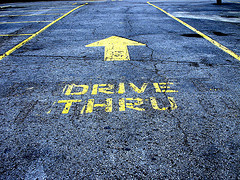Have We Reached A Saturation Point On Drive-Thrus?
Depending on where you live, you can get anything from food to cash to drugs (prescription) to liquor and porn via a drive-thru window. But is it possible that we may be experiencing diminishing returns on these supposedly convenient services?
One town in New Jersey is reportedly considering a ban on any new drive-thru businesses, saying they have become a traffic nuisance — and they may be on to to something.
After all, is the drive-thru any faster than going in to the store? That likely depends on the type of business and the time of day you’re drive-thru-ing.
In our experience, going to the drive-thru at a fast food joint during morning or evening drive time can be a significantly longer wait than simply running in and going to the counter.
This is especially true when someone in front of you has an issue with their order. Drive-thrus are efficient at ordering, taking payment and handing out food until someone complains about a missing hash brown or not getting correct change. This causes the conveyor belt to stack up and can result in angry customers — some of whom will then go inside and start an actual fight.
But inside most businesses with drive-thru lanes, there are at least two lines open to serve customers. So when there is a problem with an order, it shouldn’t back things up for everyone else.
This also leads to a bigger question of disconnecting the customer from the retail employee. When you step up to a counter inside of a business, you can usually see why you might not be getting immediate service. It might not be a good reason, but this bit of knowledge is still better than sitting at a drive-thru speaker wondering if anyone knows you’re alive.
And sometimes that lack of face-to-face interaction can free up the inner A-hole inside either the customer and/or the worker, freeing each to perhaps not be as polite as they would be if they were looking the other in the eye.
Beyond all of this, drive-thrus can take up a significant chunk of real estate that might be better occupied by expanding the building, or parking spots, or even just some pretty shrubs.
Of course, for parents with young children, all of these points might mean absolutely nothing.
Drive-thrus allow parents to avoid the repeated buckling/unbuckling process for each child. It also means they don’t have to worry about kids acting up or getting distracted while trying to deposit a check or pick up dad’s prescription refill. And you never have to worry about feeling like you’re doing a bad thing by leaving your older child in the car while you run in to grab some milk.
And, going back to the Fotomat era, a handful of businesses have done very well by becoming drive-thru only (or at least primarily drive-thru), as it allows them to keep overhead costs down and minimize staffing needs. Thus, a ban on new drive-thrus could inhibit innovation or drive some businesses to other towns.
Like many of the issues we cover, this one has no cut-and-dry answer, but it’s definitely something we think is worth having a public discussion about. And so we open the floor up to you, the readers of Consumerist, to drive up to the comments window and drop off your thoughts.
Want more consumer news? Visit our parent organization, Consumer Reports, for the latest on scams, recalls, and other consumer issues.


